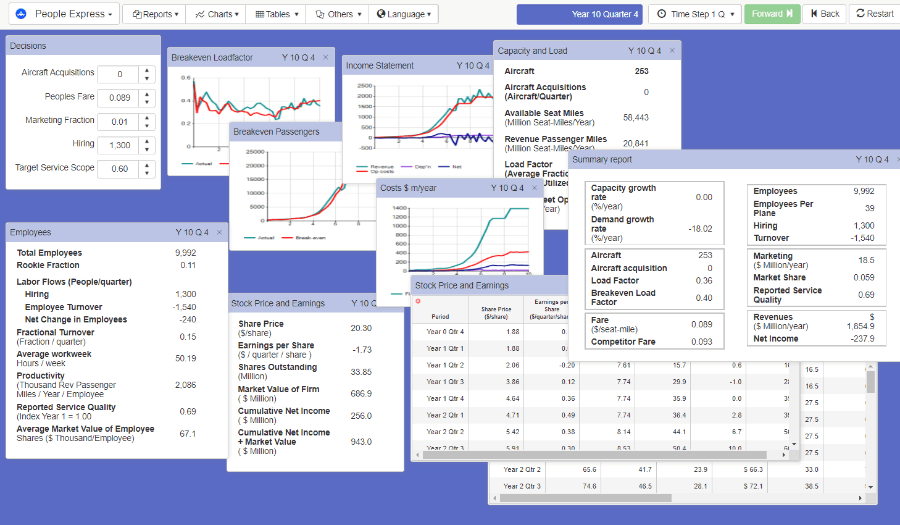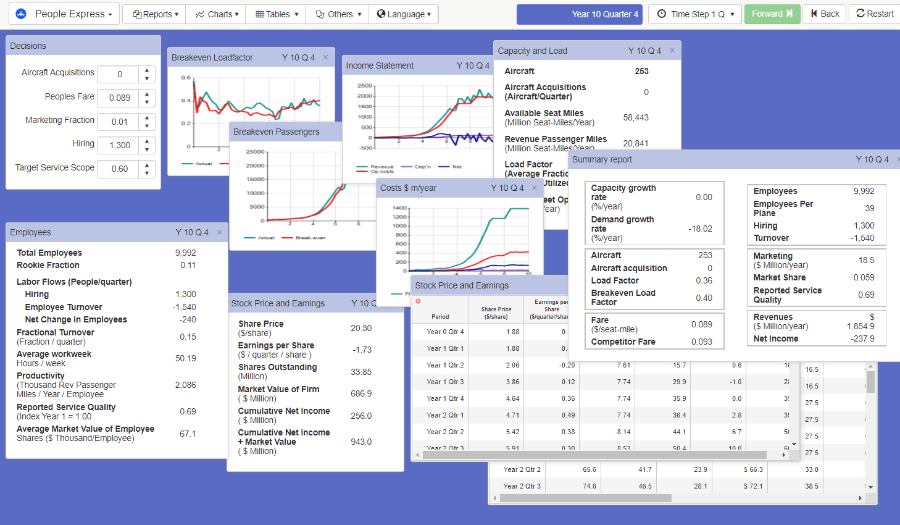People Express
The rise and fall of a remarkable business phenomenon
In 1981, People Express Airlines was launched and a business legend took off. By 1986 it was the fifth largest airline in the US with a $1 billion annual revenue. Its innovative management style and structure were praised as the wave of the future and companies worldwide rushed to imitate. Yet by 1986 it was nearly bankrupt, at the last minute was acquired by Texas Air.
The People Express Management Flight Simulator gives teams the opportunity to find out what went wrong by 'flying' the company themselves. They will take command of the firm and pilot it from start-up to success - or failure. In each simulated time period they make strategic and operational decisions, and receive feedback from past decisions. Teams decide how fast to grow, how to set prices, how aggressively to advertise. Hiring policies influence morale, productivity and turnover; marketing efforts will shape the growth of demand; but competitors will fight back. The business may go bankrupt or grow to dominate the industry.
This simulator offers insights into the issues raised by the case history of this remarkable business, illustrating the difficulties of coordinating operations and strategy in a growth market and understanding the dynamic interconnections within a firm, its market and its competitors. The flight simulator is a laboratory in which teams can systematically explore the consequences of different strategies without risking the fortunes of the real enterprise.
This business simulation was created by Professor John Sterman at MIT.
Play Video
Video: Introduction to the game interface, with audio (4 mins)

Features
Teams control strategy by making a small number of key decisions, and can progress through the simulation at their own pace, trying alternatives and saving scenarios.
Teams make management decisions on a Quarterly basis and can select to run forward at any time. Feedback is given via reports, graphs and tables that give information on profitability, market and operations.
This game can be played by individuals or small teams. It plays out business performance over a time-scale that is long enough to experience the complexity of strategy and decision-making. Teams control strategy by making a small number of key decisions, and can progress through the simulation at their own pace, trying alternatives and saving scenarios.
The game can be viewed in English, Simplified Chinese and Japanese
| Feature List | |
|---|---|
| DECISIONS | Six decisions: Aircraft purchases, Fares charged, marketing as a fraction of revenue, hiring and target service scope Teams choose when to run forward and the simulation runs forward one quarter with each step, or teams can choose to repeat decisions over several quarters. A 'Go back' option allows previous decisions to be revised an alternative strategies explored. |
| REPORTS | Numerical reports showing relevant financial and operational data. |
| GRAPHS | Preset graphs showing the history of key data items. Additionally, Any item appearing in a table can be represented as a graph - simply double click on the table heading. |
| TABLE DATA | Tables show history of financial and service data, as well as a single table of all public data and one of user decsions. Tables can be exported in CSV format to enable analysis. |
| SAVE COMMENTS WITH GAMES | Can add comments to games either for display in games list or in a "Game Notepad". |
| COPY TO OTHER APPLICATIONS | Use screen capture to obtain images of Reports or Graphs for copying into other applications for inclusion in documents and slide presentations produced. |
Uses
Key learning points
The purpose of the simulator is to give you insight into the issues raised by the case; to illustrate the difficulties of co-ordinating operations and strategy in a growth market; and to understand the dynamic interconnections among a firm, its market, and its competitors.
In summary
Business systems, like other complex social systems, show complex behaviour over time
This complexity is caused by the feedback that occurs in all real-world cases, whether reinforcing growth (e.g. from word-of-mouth amongst passengers), imposing limits to growth (e.g. failure to provide sufficient aircraft) of triggering rapid collapse (e.g. pressure on staff driving resignations, which further raises pressure on those who remain)
Good managerial policy depends on detecting – and responding appropriately to – well-chosen performance indicators.
Management performance in this aim is typically undermined by misperceptions of how the systems they are trying to control are likely to behave, due to the feedback caused by this complexity.
The flight simulator is a laboratory in which you can systematically explore the consequences of different strategies without risking the fortunes of the real enterprise.

Reviews

In 1981, People Express Airlines was launched and a business legend took off. By 1986 it had a $1 billion annual revenue. Yet by 1986 it was nearly bankrupt, and at the last minute was acquired by Texas Air.
The People Express Management Flight Simulator gives teams the opportunity to find out what went wrong by 'flying' the company themselves.
Play a demo
Teachers can request access to full game and inspection documentation for evaluation